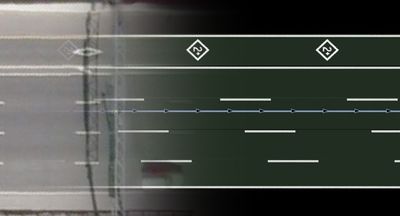JA:Key:hov
 |
| 説明 |
|---|
| 高速道路での車両通行区分を指定します |
| グループ: 道路 |
| 適用できる要素 |
| よく併用されるタグ |
|
| 関連項目 |
| 状態:使用中 |
| ツール |
hov=* (![]() high-occupancy vehicle) tag は、同乗者数での車両通行制限を示します。 このタイプのアクセス制限は地域によって、カープール、Diamond、T2制限、T3制限、などとして知られているかもしれません。(訳者注:日本では自動二輪車の二人乗り通行規制など)
high-occupancy vehicle) tag は、同乗者数での車両通行制限を示します。 このタイプのアクセス制限は地域によって、カープール、Diamond、T2制限、T3制限、などとして知られているかもしれません。(訳者注:日本では自動二輪車の二人乗り通行規制など)
値
hgv=* と bus=* に関連する hov=* は、ウェイのすべての車線に対してデフォルトで許可されているとみなす、あるいは権限階層にしたがってアクセス許可を付加設定します。
道路のいくつかのレーンが異なるHOV制限に指定されている場合(例:common on carriageways)、hov:lanes=* を使ってレーン毎にアクセス指定を設定するべきです。
指定可能な値については access=* を参照のこと、
一般的な使用例:
- designated: 多搭乗車両用に指定されている。
- yes: 多搭乗車両用が許可されている。この部分だけでは他の車両種別が通行を制限されるとは示しません。
- no: 多搭乗車両用の通行が許可されていない。この部分だけでは他の車両種別が通行許可されていると示していません。
lane: 非推奨 ウェイにこれがある場合には代わりにhov:lanes=*としてレーン毎にHOVアクセス制限を設定するべきです。
よく使われる修飾:
hov:minimum=*典型的な値として '2' (for "2+" lanes) や '3' (for "3+" lanes) が使われます。
hov:lanes=*
hov:lanes=* は、いくつかのレーンHOV制限が多のレーンと異なってい場合に使用されます。これについては Lanesの記事に道路のレーンについての詳細なタグ付け方法が記載されています。
As taken from the Lanes article, specifically regarding HOV lanes, "(hov:lanes=* is) most useful if entrance/egress is permitted at any point along the route; if entering or exiting the HOV lane(s) is only permitted at certain locations, modeling the HOV lane(s) as separate ways is preferable."
ここではレーンがタグ付けされる例を示します。
ドライビング方向
アクセス許可の継承を使用しない
highway=motorway lanes=4 oneway=yes motor_vehicle:lanes=no|yes|yes|yes hov:lanes=designated|yes|yes|yes hov:minimum=2
これは4車線の一方通行路で、最左側のレーンが二人以上の同乗者(運転手込)の通行に指定されている。HOV車両は4つの車線すべての通行が許可されている。 Note that with highway=motorway, motor_vehicle=yes は通常の自動車の通行に限定されていることを含んでいます。The motor_vehicle restriction, higher in the access restriction tree, is combined with the narrower hov allow permission, so '"all" motor vehicle traffic cannot use the leftmost lane, but HOV 2+ traffic is designated for it.'
許可の継承を使用する
highway=motorway lanes=4 oneway=yes motor_vehicle:lanes=no||| hov:lanes=designated||| hov:minimum=2
In this case, we use the fact that highway=motorway has certain default permissions, specifically, motor_vehicle=yes, and hov=yes. We do not have to specifically tag the way with 'motor_vehicle=yes', nor 'hov=yes'. A lane whose access isn't specified (there is nothing between the two || symbols) will use the defaults, which in both these cases, are 'yes'. The two examples above are functionally identical.
Two driving directions
In the common case of two driving directions either :forward or :backward is added to the end of the key.
oneway=no lanes=6 lanes:forward=3 hov:lanes:forward=designated|yes|yes hov:lanes:backward=designated|yes|yes hov:minimum=3
This is a road with three lanes in each direction. 3+ HOV vehicles are designated on the leftmost lane in each direction. Additional restrictions would have to be added for other vehicle types for these lanes, if necessary.
Please note that the lanes are viewed in the respective driving direction; i.e., hgv:lanes:forward describes the lanes in the same direction as the osm-way and the first lane-value refers to the leftmost lane in this direction, whereas hgv:lanes:backward describes the lanes in the opposite direction of the osm-way and the first lane-value refers to the leftmost lane in that direction.
As stated above, please reference Lanes for a complete specification on how to perform HOV access restriction on a per-lane basis.
Editor support
JOSM
HOV lanes can be visualized during editing with the style Land and road attributes using the key hov:lanes=* and a lane-value of designated. The following screenshot shows a motorway tagged with hov:lanes=designated|yes|yes|yes|yes and hov:minimum=2.
